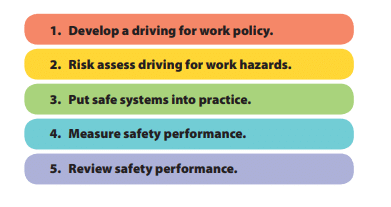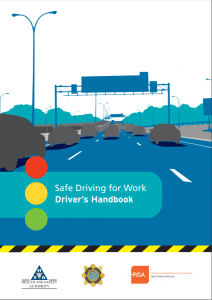Driving for Work Copy
Driving for Work
Driving for work involves a risk not only for drivers, but also for fellow workers and members of the public such as pedestrians and other road users who share the road space. Employer or self-employed persons, have a legal duty to manage the risks that drivers face and create for others when they drive for work. Businesses, employees and the community all benefit from safe driving for work.
Safe systems should be put in place to make sure that employees comply with your driving for work policies. Employers cannot directly control road or weather conditions, but they can influence the way their employees act and behave on the road.
What the Law Requires
Health and Safety law applies to driving for work in the same way as for all work activities. Employers should have a safety management system in place for managing all work related risks. Driving for work risks should be managed as part of this system. You must also make sure your employees are:
- legally entitled to drive the vehicle they are using,
- using a vehicle that is safe and roadworthy,
- trained, competent and fit to drive their vehicle safely, and
- using their vehicle safely.
While drivers are responsible for how they drive, employers are responsible for putting procedures in place that make sure employees drive for work safely at all times.
The laws that require safe driving for work in Ireland include:
- Road Traffic Acts and associated regulations: relating to vehicles, driver licensing, driving offences, insurance, rules of the road and speed limits;
- Road Transport Acts and associated regulations: relating to road haulage and road passenger transport operations, transport managers professional driver hours;
- European Communities (Road Transport) (Organisation of Working Time of Persons Performing Mobile Road Transport Activities) Regulations 2012: relating to working time of mobile road transport workers; and
- Safety, Health and Welfare at Work Act 2005 and associated regulations: relating to work activities, workplaces, work equipment and worker protection
- General Applications Regulations 2007
These laws are not just there to protect people, they are also good for business. Complying with these legal requirements will help you achieve:
- reduction in road collisions,
- fewer employee injuries,
- less absenteeism,
- lower maintenance costs,
- lower vehicle repair costs,
- lower insurance premiums,
- improved compliance with legislation, and
- lower fuel costs.
A Safe Systems Approach to Managing Driving for Work
Your business has a legal duty to manage health and safety at work. This is a wide-ranging requirement: it should be part of the everyday work process and part of good management generally. Remember, you need to have a suitable driving for work management programme as part of your overall system for managing health and safety at work in your business.
There are five key steps that you should include in your programme for managing driving for work.

Develop a Driving for Work Policy
The driving for work policy should:
- outline the aims of your safe driving for work policy;
- emphasise management’s commitment to this policy;
- refer to the relevant legislation and guidelines;
- give an overview of the business (nature of business, work locations, organisational structure, number of
employees) - identify to whom the policy applies and to whom it does not apply;
- explain how you will manage driving for work; and
- give details of resources and responsibilities.
A person should be appointed to manage driving for work. This person should be clear about their role and responsibilities and have authority to make sure that the policy is put into practice. There should also be structures in place in your business that encourage co-operation between people and departments, for example between the fleet, HR, and the health and safety manager.
Risk Assess Driving for Work
Consider all of the ways in which your employees operate a vehicle. Talk to staff to identify the hazards that they routinely encounter and any hazards which it could reasonably be anticipated that they will encounter. Record all the hazards employees face when driving for work and assess the risks involved with each. This will help decide on the most effective way to control these risks.
Consider the risks associated with:
- intoxicated driving;
- driving at inappropriate speeds;
- distracted driving;
- using safety equipment provided in and for the vehicle;
- dealing with collisions;
- dealing with breakdowns and emergencies;
- vehicle requirements; and
- journey planning
Put Safe Systems into Practice
Describe the steps employees and supervisors will take to manage identified risks.To manage driving for work effectively, you need to have systems in place that will:
- make sure everyone knows their role and responsibilities;
- make sure that drivers and managers have the right skills and proper training;
- help you keep up to date records on each driver, including:
- driving licence class and expiry date,
o driver’s hours and working time,
o penalty points and motoring convictions,
o collisions and incidents,
o mileage for each work year, and
o training and assessments (date and results); and
- driving licence class and expiry date,
- make sure vehicle checks, inspections and maintenance are regularly carried out so vehicles are kept in a safe and roadworthy condition at all times.
Measure Safety Performance
This involves checking that the aims of your driving for work management programme are being met.
These checks should include:
- analysing incident reports,
- regular driver licence checks,
- regular checks with the drivers on their penalty point status,
- review of vehicle tracking and event data recorders,
- regular driver health checks,
- checks on driver driving time, breaks and rest periods, and
- regular review of preventative and planned vehicle maintenance activities.
You should encourage your drivers to report any driving for work incidents, including near misses. This feedback will help you to deal with the underlying causes of road collisions and potentially save lives. You should also keep records of all collisions and near misses, as well as investigating and following up with safety improvements to prevent similar problems happening again.
Review Safety Performance
It is important that you review your driving for work programme on a regular basis. This review should identify any trends and also assess if employees are following the programme. You can then use the results of this review to make regular improvements to your business’s driving for work programme and procedures. When setting up a Safe Driving for Work programme, it is useful to look at the experiences of other employers who have been successful in this area. There are a range of Driving for Work business case studies available at drivingforwork.ie
Safe Driver

Drivers of company cars, vans, buses and Heavy Commercial Vehicle (HCVs) are more likely to take risks and to be at fault when a driving incident occurs.
This is not just due to driving skills and attitudes. Driving for work involves specific risks because of the type of vehicles driven and the amount of time spent behind the wheel. The greater the time spent behind the wheel, the greater the exposure to risks associated with driving for work.
Employers should check that drivers always have a valid driving licence, insurance, tax and roadworthiness certificates for each vehicle driven. In addition it is important to check your driver’s health and medical history. Drivers have an individual responsibility for their driving behaviour and must assess their own fitness to drive. They should never drink and drive, drive when tired, or drive under the influence of drugs (either prescribed or over the counter).
Some important rules for your employees to follow when driving for work might include:
- carry out pre journey checks,
- switch off your mobile phone while driving; check for messages during scheduled breaks,
- avoid being distracted when driving by phones, hand held devices, passengers or satellite navigation,
- make sure you have a safe and comfortable driving position,
- drive with seat belt fastened and make sure that all passengers are wearing their seat belts before driving,
- drive with lights on at all times,
- observe and obey road safety signs, in particular road signs warning of road works,
- observe and obey speed limits,
- stop driving if you are feeling tired or sleepy; find somewhere safe to rest straight away,
- report any collisions or near misses to Gardaí and your employer, and
- always park legally.
Safe Vehicle

Daily vehicle pre-use checks are a simple and effective way to spot potentially dangerous issues or defects before vehicles are used. Employers and self employed people should have a system of routine daily checks in place to ensure that vehicles are in good working order, safe and fit for purpose. Drivers must know their vehicle capabilities and not exceed them. They should familiarise themselves with the correct operation of their vehicle. For information on how to carry out a daily vehicle walkaround pre check for cars, vans, buses and heavy commercial vehicles (HCVs) visit www.drivingforwork.ie
Drivers using their own vehicle for work are responsible for its roadworthiness, motor tax, insurance and condition. The motor insurance policy must include cover for business use. The vehicle must have a valid certificate of roadworthiness (NCT or CVRT) and be serviced according to the manufacturer’s recommendations. Employers have a legal duty to check that the employee’s vehicle is safe and legal when it is being used for work and you may request documentary evidence to confirm this.
Drivers should:
- only carry loads for which the vehicle is suited (remember: a car is not a van),
- only carry the number of passengers for which seat belts are provided and working,
- not use the vehicle in conditions for which it is not designed (for example off-road),
- keep at least one hi-visibility jacket in the cab or glove compartment, and
- carry a torch, first aid kit and warning triangle.
Safe Journey
Almost all road collisions involve human error, ranging from simple mistakes to deliberate dangerous and illegal behaviour. Every year people are killed in collisions in which someone was careless, reckless or in a hurry. Speed is the single biggest contributory factor in vehicle collisions.
There are some straightforward steps drivers can take to make their journey safer:
- allow plenty of time so you are not under pressure to drive at unsafe speed,
- plan and note your route before setting out,
- plan for the safest route, avoiding urban and residential areas if possible, particularly schools,
- try to use dual-carriageways and motorways where possible,
- check travel and weather information before travel and during the course of your journey,
- slow down or even cancel your journey in severe weather conditions such as heavy rain, fog, high winds, ice or snow,
- always use daytime running lights,
- plan when and where you will take breaks. Rule of thumb is a 15 minute break for every two hours driven,
- always drive in a safe and legal manner; and
- be courteous and considerate of all other road users when driving for work.
Employers you should have procedures for emergencies such as accidents or breakdowns. Ensure that drivers have the following in their vehicles:
- a copy of the emergency procedures,
- contact details of the person(s) to whom you should report emergencies and incidents,
- contact details of the breakdown firm and insurers your organisation uses and any reference numbers that may be needed to quote, and
- a fully-charged mobile phone to call for help if necessary. Do not use the phone while driving.
When dealing with collisions and emergencies, personal safety and the safety of any passengers should always be your first consideration. Use your hazard warning lights and high visibility clothing to make sure you and your vehicle can be seen by other road users. Never leave the scene of a collision. Collisions that result in injury while driving for work should be reported to the Gardaí and your line manager immediately. Details should be recorded on a preliminary incident report form.
Additional Information
For more details on Driving for Work and Work Place Transport Safety, please follow http://www.vehiclesatwork.ie/
The RSA, HSA and An Garda Síochána have developed a number of resources to help you to develop and implement safe driving practices in your Company: http://drivingforwork.ie/
Useful Websites
- Driving for Work http://drivingforwork.ie/
- Vehicles at Work http://www.vehiclesatwork.ie/
- Road Safety Authority https://www.rsa.ie
- An Garda Síochána at https://www.garda.ie
Published Handbooks

Download the Driving for Work – Driver Health Guidelines here

Download the Safe Driving for Work Handbook here

Download the Driving_for_Work_Your_Questions_Answered_ here